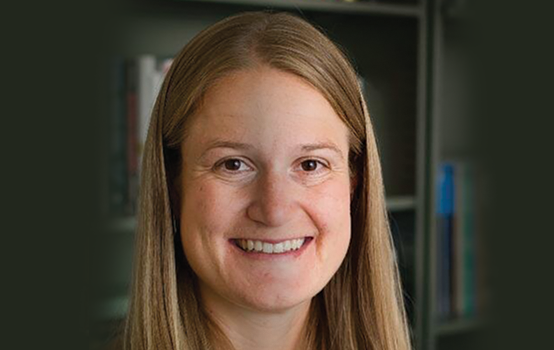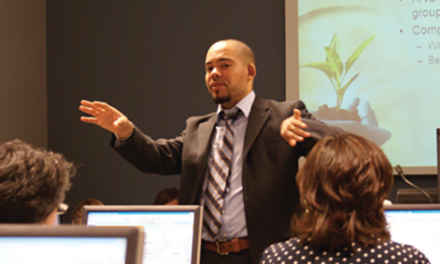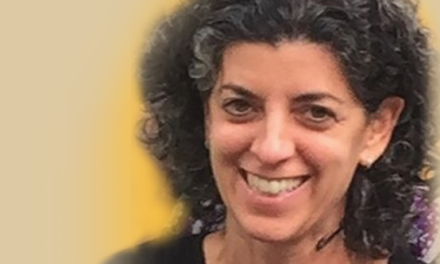Kappan‘s editor talks with Sarah Reckhow about her research into the ways the Gates Foundation and other big spenders have influenced K-12 education.
 KAPPAN: In preparation for this issue of Kappan, we compiled a list of all the people who wield power and influence over K-12 education, from the local level to state capitals to Washington, D.C. It’s a pretty big cast of characters: students, parents, teachers, principals, superintendents, district and state school boards, community groups, business leaders, unions, professional associations, advocacy and reform groups, think tanks, higher education leaders, publishers, journalists, academic researchers, teacher educators, accrediting agencies, mayors, governors, state legislators, the U.S. Department of Education, Congress, the White House, and — the subject of much of your research — private foundations.
KAPPAN: In preparation for this issue of Kappan, we compiled a list of all the people who wield power and influence over K-12 education, from the local level to state capitals to Washington, D.C. It’s a pretty big cast of characters: students, parents, teachers, principals, superintendents, district and state school boards, community groups, business leaders, unions, professional associations, advocacy and reform groups, think tanks, higher education leaders, publishers, journalists, academic researchers, teacher educators, accrediting agencies, mayors, governors, state legislators, the U.S. Department of Education, Congress, the White House, and — the subject of much of your research — private foundations.
Over the last century, which of these players have had the greatest influence over what goes on in the public schools? Can you give us a quick overview of the historical trends?
SARAH RECKHOW: Going back to the late 1800s and first few decades of the 1900s, the greatest influence belonged to those who were tied most closely to the profession of education — administrators, teachers, and the faculty who prepared them. From time to time, elite educators (for example, the members of the Committee of Ten, which included the presidents of Harvard and other universities) stepped into the spotlight and had an enormous influence on the curriculum. Also, in the early 20th century, local districts were created, and they had significant influence over policy and practice. By the middle of the century, state departments of education were taking on larger roles, too.
You could also argue that wealthy funders had a lot of influence in the early 1900s. For example, the Carnegie Corporation was behind the establishment of the Carnegie Unit, and the Rosenwald Foundation played a big role in establishing schools for African Americans in the south. In general, though, private philanthropy was a much smaller sector than it is today.
KAPPAN: When did the federal government become a major player? Would you point to the passage of the first Elementary and Secondary Education Act in 1965, or did the federal role really begin to take off with No Child Left Behind (NCLB) in 2001?
RECKHOW: People cite a range of things, but I tend to point to the Nation at Risk report in 1983, which helped create the perception that our schools were falling behind and that this would undermine American competitiveness in the global economy. That led to a new set of actors taking a more prominent role in shaping policy: corporate leaders, governors, and eventually Congress and presidents. By the time NCLB was passed, this had been building for two decades already, with state and then federal officials rallying around the push for standards and accountability.
KAPPAN: As influence shifted toward business leaders, governors, and the federal government, who got pushed aside? Whose influence weakened?
RECKHOW: It’s not necessarily a zero-sum game, where one person’s gain means somebody else loses out. In general, we’ve seen an accumulation of people trying to influence K-12 education. The stage keeps getting more crowded.
Enter the foundations
KAPPAN: You’ve written a lot about the growing influence of private philanthropy in education. How and when did foundations such as Gates, Broad, and Walton become such major players in school reform?
RECKHOW: Again, it’s worth noting that foundations have always been active — you could go back to Carnegie’s influence on the standardization of credit hours and teaching assignments, for example; or you could point to the Annenberg Foundation’s massive investment in school improvement in the 1990s. But the role of the philanthropic sector really exploded in the 2000s, especially with the entrance of the Gates Foundation.
Gates is just so huge that it’s hard to compare its work to previous philanthropic initiatives in K-12 education. And of course, in 2006, Warren Buffett added $30 billion to the Gates endowment, making the foundation even more enormous. Meanwhile, the Walton Family Foundation expanded its programs, the Broad Foundation was created . . . So we saw truly unprecedented growth in the amount of private money flowing into education. Further, some of the largest funders began to support closely related policy objectives, often choosing to fund the very same organizations, which ramped up their influence. For an organization like the KIPP network or Teach For America, budgets scale up pretty dramatically when you have Gates and Walton and Broad and several other foundations supporting you.
KAPPAN: You’ve used the phrase “singing from the same hymn book” to describe the ways in which those foundations have coordinated and concentrated their giving. Did they sing the same hymns from the beginning, or did they grow closer over time?
RECKHOW: I would say that evolved over time. For instance, Walton’s approach, starting out, was to invite people to submit applications to create individual charter schools. Over time they took more of an interest in funding charter management organizations, and that led them to fund policy and advocacy organizations, which brought them closer to Broad’s strategy. And of course, Gates started out with a focus on small schools. It wasn’t until they started to focus on teacher quality that Gates, Broad, Walton, and others really began to share the same hymn book.
But I want to add a caveat: There are thousands of private foundations that give money to education, and their missions vary in all sorts of ways. In my research, I’ve focused only on the foundations with billions of dollars to spend. I can’t really generalize about what’s going on with the thousands of smaller funders whose budgets might be “only” a couple million dollars a year.
KAPPAN: But as you’ve pointed out in your research, even the very biggest funders give only a fraction of what the federal government spends on K-12 education and, in turn, that’s only a fraction of what states and districts spend. So how have Gates, Broad, and other big foundations turned their relatively small investments into large amounts of influence?
RECKHOW: I’d highlight three strategies that they’ve pursued. The first one I’ve already mentioned: They’ve aligned their strategies, which allows them to amplify each other’s messages. Second, they’ve targeted their funding to specific school districts and states, rather than spreading themselves thin across the country. The best example is probably the $100 million that Mark Zuckerberg gave to the Newark, N.J., public schools in 2010. When you concentrate your giving like that, it’s no longer just a drop in the bucket. Even for a large district, $100 million is a lot of money.
And the third is that they’ve tried to leverage their investments by getting states and the federal government to adopt their favored strategies. Partly they’ve done this by cultivating relationships with key policy makers, partly by funding advocacy groups and think tanks to promote their ideas, and partly by funding the early development of programs that can be scaled up with public dollars.
KAPPAN: How successful have they been?
RECKHOW: Well, that depends on whether you’re talking about short- or long-term victories.
Let’s look at the short term first: The big foundations certainly have had an influence on the adoption of policies and programs. For example, Gates had a hand in every part of the Common Core State Standards, paying for the writing of the standards, funding the National Governors Association to mobilize support for them, funding advocacy groups to promote them, funding the creation of new assessments, and so on. And the effort was successful in the sense that the standards were published in a timely fashion, praised by a wide range of experts and policy makers, and adopted by 42 states and the District of Columbia.
It’s entirely fair to ask whether extremely wealthy people should have a much louder voice than everybody else.
Or consider the federal Race to the Top (RTT) initiative, which included strong incentives for states to adopt tough new teacher evaluation systems — a high priority for the Gates and Broad foundations. To find out what arguments were presented to policy makers during the run-up to RTT’s passage in 2009, Megan Tompkins-Stange (from the University of Michigan) and I analyzed the congressional testimony on teacher quality issues. What factor was most associated with speaking in favor of teacher evaluation as a strategy to improve teacher quality? It wasn’t whether the speaker was a Democrat or Republican, policy wonk or practitioner. Rather, one of the strongest associations (and likely the strongest — the statistics are complicated) was whether the person giving the testimony was a grantee of the Gates Foundation.
Now the reality is that teacher evaluation is a really complicated issue, and there’s a whole debate to be had about different ways to do it, how it works in practice, whether it’s valid and reliable, and so on. But when RTT was on the agenda, the debate became very narrow. Instead of looking at all of the available research and asking difficult questions, people tended to rely on a short list of studies from think tanks and other advocacy organizations (that had received major foundation funding).
A sprint or a marathon?
KAPPAN: So you’re saying that big foundations, especially Gates and Broad, helped create political coalitions that got most states to adopt the Common Core and (through Race to the Top) implement test-based teacher evaluation systems. But you’ve also argued that these were just short-term victories. As you’ve written, the foundations have been so focused on winning the sprint that they haven’t prepared for the marathon of long-term school improvement.
RECKHOW: Right, but to understand why, it’s helpful to go back to the Annenberg Foundation’s challenge grants in the 1990s. Annenberg’s strategy was to invite people to come forward with ideas about how to improve schools in New York and L.A. and Detroit and various other places. They got all sorts of proposals, chose the best ones, and gave their grantees a lot of discretion to create their own programs. But in the end, most observers were disappointed in this approach. It generated a hodgepodge of models, with no clear sense of which approaches were most effective, and while the amount of funding ($500 million spread over 18 projects) was unprecedented at the time, it wasn’t enough to have a major impact on school systems.
So when Gates and Broad came along, in the 2000s, they argued that instead of trusting the field to come up with good ideas, funders needed to do more to set the agenda, define their own priorities, and seek more consistency among grantees. Plus, they were hoping for outcomes that would impact millions of schoolchildren. But they realized that even if they spent billions of dollars, that would still add up to just a drop in the bucket compared with federal, state, and local funding. So how could they have a truly game-changing impact? They decided to focus on policy change: If they could influence state and federal policy making, then that would trigger much bigger investments than their own endowments would ever allow them to make.
Of course, the flip side is that educational policy tends to operate at a 30,000-foot level, far removed from the realities of life in schools and classrooms. And while you may be able to get a policy changed, you have very little control over the ways in which superintendents and principals and teachers will implement it, or whether they’ll think it’s relevant to the messy, real-world challenges they face every day, or whether they’ll think it’s a good idea at all. So it was likely that, over time, Gates and Broad and other foundations would face some backlash from practitioners, parents, and others.
KAPPAN: At times, that backlash has been pretty intense and even personal, with Bill Gates, especially, coming in for some harsh criticism. To what extent has that criticism been fair?
RECKHOW: I have mixed views on this. I’m certainly not inclined toward the view that the big funders have some sort of evil or profit-driven motive. People sometimes argue that the Walton family supports charter schools because they, and their Walmart stores, are anti-union. Or they say that Gates is using his foundation to promote Microsoft. But I just haven’t seen evidence to support that kind of criticism. We’re talking about extraordinarily rich individuals, and if they wanted to get even richer, it’s hard to see why they’d create foundations to do that.
But I do see good reason to criticize the influence of big money on our political process, especially in an era of rising inequality. It’s entirely fair to ask whether extremely wealthy people should have a much louder voice than everybody else. And it’s also fair to criticize these foundations for their lack of transparency.
On this issue, there have been some improvements lately. The Gates Foundation, in particular, has tried to become much more transparent. They’ve made it very easy to look up their grants, and they regularly post reports and evaluations online. As to the Broad Foundation, I’m not sure. The last time I checked, I couldn’t find any sort of external evaluation of the Broad Superintendents’ Academy, for example. We’re talking about a program that pays people to be public employees, running school districts, so we should expect some public accountability. But we don’t know very much about the program’s effectiveness.
KAPPAN: Looking forward, what are your hopes and fears for these big foundations (and you can include the two newest players on the scene, the Chan Zuckerberg Initiative [CZI] and the Emerson Collective)?
RECKHOW: Lately, Bill Gates has shown a lot of contrition, and he seems to agree that the foundation hasn’t done nearly enough to listen to educators and think through the consequences of its policy strategies. It’s still too early to say what he’ll do next, though. Ideally, Gates and other big funders will swing the pendulum back toward letting the field define the funding agenda. I don’t think we’ll see anything like a return to the hands-off approach of the Annenberg days, but I do hear a shift in the way funders are talking.
At the same time, I’m worried by some of the rhetoric that’s coming out of CZI and Emerson. In particular, CZI’s messages about personalized learning remind me of the way people talked about teacher evaluation several years ago, as if they’d found a silver bullet: “If you just do this one thing, schools will be transformed.” They’d probably argue that it’s important to have big goals for kids and schools. But in recent years, that kind of super-confident attitude has led funders to set expectations that are totally divorced from reality. I understand the desire to be ambitious, but I’d urge them to be a lot more pragmatic and careful.
I’d also urge them to be a lot more transparent. And here I’m pretty worried about CZI and Emerson because they’ve registered themselves as LLCs, which means they don’t have the same reporting requirements as foundations. It’s entirely up to the individuals who lead those organizations whether they want to let the public know what they fund and with how much money.
The rush to influence school boards
KAPPAN: In collaboration with Jeff Henig and Rebecca Jacobson, you’ve recently done some research into a wave of big spending that has gone into local school board elections. What have you found so far, and is this spending related to the foundations’ efforts to influence education policy making?
RECKHOW: It’s a lot of money, and it seems to be funneling into certain school districts — for example, the recent Los Angeles school board election was far and away the most expensive school board race ever. We noticed a big uptick in out-of-state contributions to local school board candidates around 2010 or 2011. So the timing coincides with the Supreme Court’s Citizens United decision, which eased restrictions on campaign contributions, but Citizens United isn’t necessarily the causal factor here — it may just be that school board elections have been affected by a general trend toward more expensive campaigns.
KAPPAN: Is the money going mostly to support candidates who support charter schools, as was the case in Los Angeles?
RECKHOW: Yes and no. We’ve been studying five districts where we’ve seen a surge in out-of-state contributions to school board candidates — L.A., Denver, New Orleans, Indianapolis, and Bridgeport, Conn. Bridgeport is a bit of an outlier, in that charter schools aren’t a big focus there. Overall, though, we’ve found that this money has consistently gone to candidates and organizations that we would put into the category of “school reformers,” whom we associate with the policies promoted by RTT, including strong support for expanding the charter sector. The issue of expanding charter schools is prominent in election-time media coverage in L.A., Denver, and New Orleans. And yes, the big money flowing in from other parts of the country does consistently go to the reform candidates, rather than candidates backed by teachers unions. Also, we’ve collected the federal campaign contributions for all of these out-of-state donors, and — interestingly — it looks like they’re predominantly Democrats.
We do see some overlap with the big funders that we’ve been discussing. Eli Broad has been one of the big donors, as has Laurene Powell Jobs, who heads the Emerson Collective. Michael Bloomberg isn’t usually associated with education philanthropy, but he’s poured a great deal of money into school board elections, as have Reed Hastings, from Netflix, and John and Laura Arnold, whose Arnold Foundation has been one of the bigger funders of school reform. We’ve also found that many of the out-of-state donors serve on the boards of reform-oriented education nonprofits, most notably Teach For America and the KIPP schools.
KAPPAN: For a long time, the teachers unions were the main power broker in a lot of school board elections. So how are they responding to this influx of out-of-state funding?
RECKHOW: They’re definitely trying to compete, especially in L.A., which is why we’ve seen these eye-popping numbers there for how much money the candidates are spending overall. And candidates are also raising a lot more local money than in the past. As a result, some of these school board elections now look like congressional races, with professional campaign staff and slick advertising. In some places, we have also seen reform-oriented organizations like Stand for Children working closely with candidates, such as by helping them identify a good campaign manager or hiring a fundraiser to work with them.
KAPPAN: Does this make it harder for other people to participate in the process? When unions and reform groups compete to get their messages out and win school board elections, how can parent advocacy groups, community leaders, and other people make themselves heard?
RECKHOW: To the extent that it raises the cost of getting involved, you would have to say that it’s harder for ordinary people to do so. On the other hand, some of this money is mobilizing other local interests that support reform. So it’s definitely changing the mix, giving more power to some people and leaving others out. But it’s hard to know what the overall effect is. You might ask an education activist in Indianapolis about this new money coming in, and they’ll say, “Thank goodness. Now we’re finally able to advocate effectively for important changes in our district.” Then the next person will tell you, “This money is destroying local democracy in Indianapolis!”
Influence in the age of ESSA
KAPPAN: The passage of the Every Student Succeeds Act (ESSA) has made it difficult to predict who will be the main power brokers and policy influencers in education over the coming years. Under NCLB and RTT, it was pretty clear that if you wanted to have a large-scale influence on public schooling, you had to target the specific members of Congress and officials at the U.S. Department of Education who were making the big decisions. But ESSA shifts power back to the states, and every state has its own distinct mix of influencers — in one state, the governor and the state board seem to hold all the cards; in another state, it’s the legislature or the teachers union or a couple of big-city mayors . . . At this point, is anybody well positioned to play an influential role across the board?
RECKHOW: It seems like the Gates Foundation is very much staying in the game. So I’d expect that in states that are still committed to the Common Core or teacher evaluation, Gates will keep trying to influence policy, even if it’s just to maintain policies that have already been adopted. But it’s a shifting environment, and in some states we’re definitely seeing other groups mobilize around competing agendas. Massachusetts is a great example: In 2016, they had this incredibly expensive battle over a referendum on allowing more charter schools, and the reformers lost, which suggests that in Massachusetts at least, the winds have shifted.
And in some other states we’ve seen parent advocates become more vocal, especially with their opposition to testing. In the bluer states, voters seem to be more skeptical about school reform than they were in the past (though, on the whole, public opinion data show that Democrats still tend to be more supportive of federal involvement in education). In the red states, people are just really skeptical about federal involvement, period.
KAPPAN: What about the recent teachers strike in West Virginia? Any thoughts as to whether teachers might return to a more activist and influential role?
RECKHOW: It’s certainly an interesting development. I don’t know about the larger trends, though. For example, here in Michigan, we recently enacted a right-to-work law, and the Michigan Education Association isn’t anything like the powerhouse that it used to be. So I hesitate to generalize about teachers’ activism in general. To the degree that we’re seeing more public organizing and protests in general, especially among groups that are more aligned with the Democratic Party, then sure, we might see teachers become more influential. But it’s just really hard to predict.
Citation: Heller, R. (2018). Big money and its influence on K-12 education: An interview with Sarah Reckhow. Phi Delta Kappan 99 (8), 41-45.
ABOUT THE AUTHOR

Rafael Heller
Rafael Heller is the former editor-in-chief of Kappan magazine.










